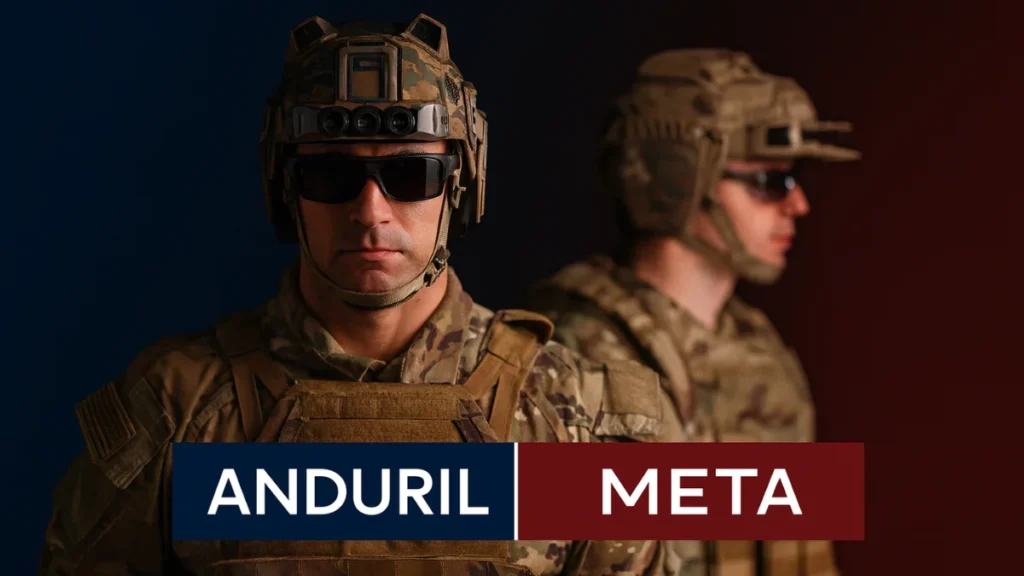Anduril has revealed its first hardware outcome from its Meta partnership — EagleEye, a mixed-reality (MR) system built into warfighter helmets.
This modular AI helmet aims to overlay battlefield data, sensor feeds, mission orders, and drone control — repositioning Meta from social media to the front lines of defense tech.
Key Takeaways
- EagleEye is a modular MR helmet powered by Anduril’s Lattice + Meta’s AR tech.
- The system overlays maps, mission briefs, drone command, threat alerts.
- Anduril plans ~100 units delivered to the U.S. Army next year.
- Meta contributes waveguides, displays, AI models; Anduril handles integrations.
- This marks a renewed collaboration between Luckey and Zuckerberg, now in defense.
EagleEye is an AI-infused mixed-reality helmet system built by Anduril with Meta’s AR and AI tech. It embeds a heads-up display, spatial audio, sensors, and command controls into soldiers’ gear—overlaying maps, mission orders, and threat intelligence directly in view.
EagleEye: What’s New and Different
Announced on October 13, 2025, EagleEye is the first hardware to emerge from the Anduril–Meta partnership. Anduril describes it as a “family of systems”: modular headsets or integrated helmet shells that embed computing, sensors, displays, radios, and AI features.
Rather than being an add-on device, EagleEye intends to fully replace standard helmets with built-in MR capabilities. Through Lattice, Anduril’s command-and-control software, soldiers can pull in real-time sensor data, overlay maps and targeting cues, and even interact with autonomous systems like drones.
Meta’s role is to supply advanced display, waveguide, and AI integration components—leveraging technology from its Reality Labs and Llama AI line.
The Legacy: From Oculus to Battlefield
This partnership has personal resonance: Luckey once sold Oculus to Meta in 2014, then was dismissed in 2017. The EagleEye initiative is thus a symbolic reunion. In his own words: “I now have all my toys back … all of it is on the table for EagleEye.”
Anduril was already involved in the U.S. Army’s mixed-reality efforts. In early 2025, it assumed responsibility for the troubled Microsoft IVAS (Integrated Visual Augmentation System) project. EagleEye may be pitched in part to succeed IVAS under what is now called the Soldier Borne Mission Command program.
Deployment & Numbers
Luckey announced that Anduril will deliver around 100 EagleEye headsets to select U.S. Army units by Q2 next year. The plan includes variants optimized for day/night use, different ballistic protection levels, and optional sensor modules (for example, hyperspectral imaging).
The modular design means soldiers or mission leads can “clip on” specialty sensors only when needed, rather than carrying an all-in bundle.
Market Reaction & Industry Pulse
Defense analysts view EagleEye as a significant escalation in military XR competition. It challenges prior vendors and raises the bar for augmented warfighter tech.
Critics point to past problems with XR systems—eye strain, latency, discomfort, and cybersecurity risks—as hurdles to deployment. Meta’s involvement is doubly controversial, since its prior stance was that commercial AI and AR tools should not be weaponized.
Risks, Ethics & Oversight
Embedding AI capabilities in combat gear intensifies the debate over autonomy, accountability, and human oversight. Soldiers may increasingly offload decisions or perception to an “AI teammate.”
Cybersecurity is another concern: what if adversaries hack or jam helmet systems mid-mission? The reliance on networked data and augmented overlays introduces new attack surfaces.
Moreover, public perceptions of Big Tech’s role in warfare could spark oversight pressure, especially with Meta’s past controversies.
Conclusion
EagleEye signals a major strategic leap: not just better goggles, but an attempt to merge AI, AR, and autonomy into the soldier’s mind.
Will Anduril win the SBMC / Army contract? How will the helmets fare in battlefield conditions? Will adversaries try to replicate or counter them?
